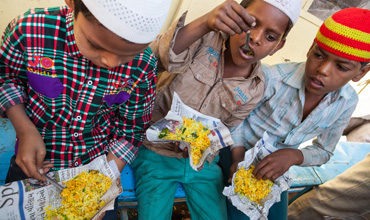Malnutrition in the Under-Fives: Assessment of the Knowledge and Practices of Mothers in its Prevention

Abstract:
Introduction: According to
the WHO, malnutrition remains the biggest contributor to child mortality with 6
million children dying from hunger each year. In 2010, protein energy
malnutrition was estimated to have resulted in 600 000 deaths from 883000
deaths, in 1990 another 8400 deaths resulted from iodine and iron deficiency.
The general objective of the study was to find out if
mothers of the under-fives leaving in the Bamendakwe Health Area are
knowledgeable of the preventive measures against malnutrition.
Materials &
Methods: A descriptive cross-sectional design was employed in
which a structural questionnaire was used for the collection of primary data
from a sample of mothers with under-five children on their knowledge in the
prevention of malnutrition.
Results: Results
obtained show that feeding a child with a balanced diet will help prevent
malnutrition in children less than 5 years.
Discussion: Mothers lacked the means to prevent malnutrition,
lacked the knowledge of different foods to feed the child to prevent malnutrition.
Ignorance and poverty are associated with malnutrition; according to Kammann
(2003), ignorance, lack of adequate funds, unemployment leads a deficit in the
means to purchase the right kind of foods rich in proteins.
Conclusion:
Malnutrition remains a serious paediatric problem in the under-fives as
mothers’ deficit on balanced dieting can result to malnutrition.
Key words: Malnutrition,
Marasmus, Kwashiorkor, Health education, Balanced Diets, Breastfeeding,
Sanitation, Behaviour Change Communication
References:
[1]. Black R,
Morris S, Jennifer B (2010). Where and Why Are 10 Million Children
Dying Every Year?
[2]. Brezger A,
Kneib T, Lang S: (2011). BayesX: Analysing Bayesian structured additive
regression models.
[3]. Caputo A,
Roraita R, Klasen S, Pigeot I (2003). Undernutrition in Benin: An.
Analysis based on Graphical Models. Social Sciences and Medecine,
56:1677-1691.
[4]. Coghlan B,
Brennan RJ, Ngoy P, Dofara D, Otto B, Clements M, Stewart T. (2010) Mortality
in the Democratic Republic of Congo: a nationwide survey. The
Lancet 2006, 367:44-51. Central Emergency Respond Fund (CERF): [The
Democratic Republic of Congo. Facts and Figures.
[5]. Doctor
without Borders: Food, nutrition and mortality situation of IDP's in Dubie.
Katanga 23-25 March 2006
[6]. Fahrmeir L,
Lang S: (2001). Bayesian Inference for Generalized Additive Mixed
Models Based on Markov Random Field Priors. Applied Statistics
(JRSS C), 50:201-220.
[7]. Gwatkin DR,
Rustein S, Johnson S, Pande K, Wagstaff A: (2000). Socioeconomic
differences in Health, Nutrition and population in Cameroon. HNP/Poverty
Thematic Group of World Bank, Washington DC.
[8]. Kammann EE,
Wand MP: (2003). Geoadditive Models. Journal of the Royal
Statistical Society C 2003, 52:1-18.
[9]. Kandala NB,
Emina JBO, Nzita DK, Cappuccio FP: (2009). Diarrhoea, acute respiratory
infection, and fever among children in the Democratic Republic of Congo. Social
Science and Medicine, 68:1728-1736.
[10]. Kandala NB,
Fahrmeir L, Klasen S, Priebe J: (2009). Geo-additive models of
Childhood Undernutrition in three Sub-Saharan African Countries. Population,
Space and Place, 15:461-473.
[11]. Klasen S:
(2008). Poverty, undernutrition, and child mortality: Some
inter-regional puzzles and their implications for research and policy. Journal
of Economic Inequality, 6(1):89-115.
[12]. Madise NJ,
Matthews Z, Margetts B: (1999). Heterogeneity of child nutritional
status between households: a comparison of six sub-saharan African countries. Population
Studies, 53:331-343.
[13]. Moradi A,
Klasen S: (2000). SFB 386 Discussion Paper No. 217. In The
Nutritional Status of Elites in India, Kenya, and Zambia: An Appropriate Guide
for Developing International Reference Standards for Undernutrition?.
University of Munich.
[14]. Mosley W,
Chen L: (1984). An Analytical Framework for the Study of Child Survival
in Developing Countries. Population and Development Review, 10:25-45.
[15]. Pongou R,
Ezzati M, Salomon JA: (2006). Household and Community Socioeconomic and
Environmental Determinants of Child Nutritional Status in Cameroon. BMC,
Public Heath, 6.98:19.
[16]. Reed BA,
Habicht JP, Niameogo C: (1996). The effects of maternal Education on
child nutritional status depend on socio-environmental conditions. International
Journal of Epidemiology, 25:585-592.
[17]. République
Démocratique du Congo: (RDC), Enquête démographique et de Santé
(EDS-RDC 2007). Rapport final 2008.
[18]. Smith L,
Haddad L: (1999). IFPRI Research Report No. 111. In Explaining
Child Malnutrition in Developing Countries. Washington DC: IFPRI.
[19]. Spiegelhalter
D, Best N, Carlin B, Van der Line A: (2002). Bayesian measures of models
complexity and fit. Journal of the Royal Stat Soc B, 64:1-34.
[20]. UNDP:
(2007). D.R. Congo Human Development Report. New York, NY: United
Nations Development Programme;.
[21]. UNICEF: The
state of the world's children 1998. New York, UNICEF.
[22]. UNICEF:
(2008). The state of the world's children 2007. New York, UNICEF;
2007. | United Nations World Food Programme (WFP): Democratic Republic of
Congo Comprehensive Food Security and Vulnerability Analysis (CFSVA) /
2007-2008.
[23]. United States
Agency for International Development: (2008). [http://www.usaid.gov/pubs/cbj2003/afr/cd/]
webcite The Democratic Republic of Congo.
[24]. World Bank:
(2009). World Development Indicators 2009. Washington DC: the World
Bank;.
[25]. World Health
Organization (WHO): (1983). Measuring Change in Nutritional Status.
Geneva;.
[26]. World Health
Organization (WHO): (2006). Multicentre Growth Reference Study. Acta
Paediatrica, 450(Suppl):1-87.
[27]. World Health
Organization (WHO): (1995). WHO Technical Report Series No. 854. In
Physical Status: The Use and
Interpretation of Anthropometry.
Geneva: WHO.

